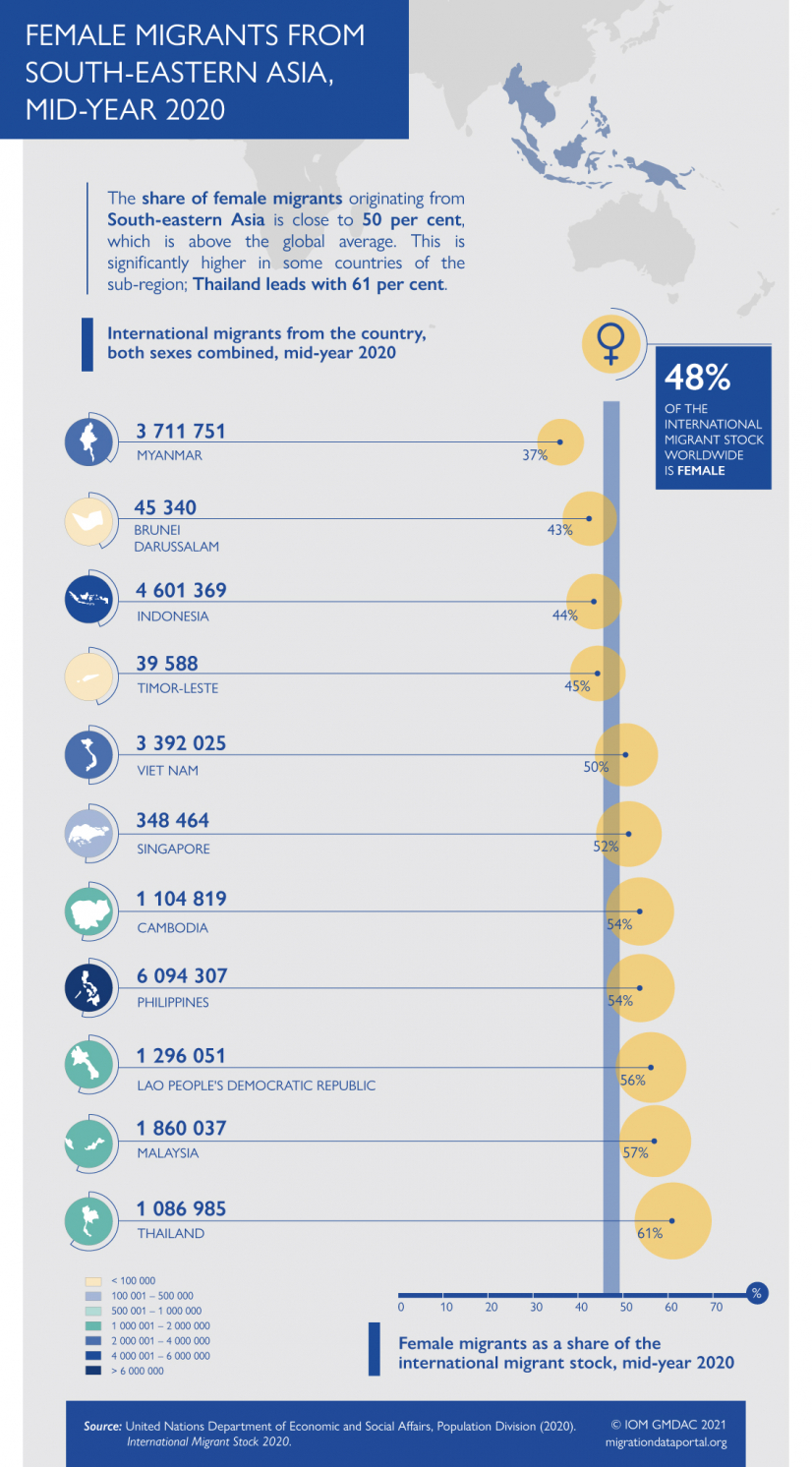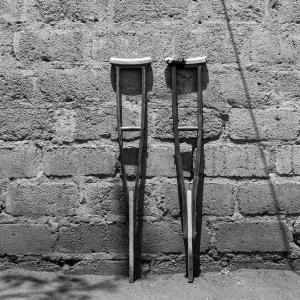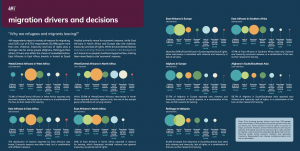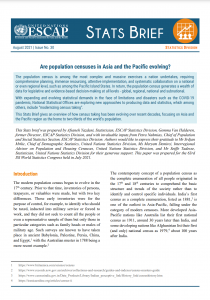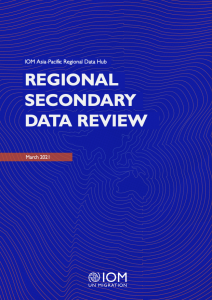
Migration data in South-eastern Asia
South-eastern Asia has, since historic times, been defined by large-scale population movements. Stretching over 11 countries – Brunei Darussalam, Cambodia, Indonesia, the Lao People's Democratic Republic, Malaysia, Myanmar, the Philippines, Singapore, Thailand, Timor-Leste and Viet Nam – and with an estimated population of 669 million people at mid-year 2020 (UN DESA, 2020), it is an important sub-region of origin of labour migrants.
While Northern America, Europe and Western Asia are important regions of destination, the majority of the 23.6 million migrants from South-eastern Asia remain on the continent and roughly a third of them stay in the same sub-region (ibid.). The rising demand for domestic and care work in Asia and beyond has led to more female migrants than male migrants from some countries in the sub-region: 61 per cent of migrants from Thailand are female and the share is well above 55 per cent in Malaysia and the Lao People's Democratic Republic (ibid.).
Recent trends
COVID-19:With 13,215,160 COVID-19 cases and 203,166 deaths as of 15 February 2021 (WHO, 2021), South-eastern Asia has fared relatively better compared to other regions. The situation, however, differs quite significantly from country to country: Singapore, the most affected, had overall more than 10,000 cases per 1 million inhabitants, while in Cambodia, Viet Nam and the Lao People's Democratic Republic, the rates have remained in the low double or even single digits (ibid.).
All countries of the sub-region imposed temporary restrictions for international travel (IOM, 2021), which included, for example, the closure of border crossing points and enhanced border surveillance, the suspension of visas, the interruption of international flights, as well as extensive testing and quarantines. This was complemented by internal measures, such as Myanmar’s domestic flight ban, and the Philippines’ suspension of public transport and use of roadblocks and checkpoints (Philippine Department of Health, 2020).
Migrants in South-eastern Asia have suffered disproportionately from COVID-19, often due to inadequate and cramped living conditions. In Singapore, for example, as of mid-February 2021 more than 90 per cent of the total 59,800 cases were migrant workers housed in dormitories (Singapore Ministry of Health, 2021), a trend to which the government reacted with movement restrictions for foreign workers (Singapore Ministry of Health, 2021). Other countries imposed restrictions for their own workforce, for example, the Philippines banned overseas travel for Filipino nurses and medical workers for several months (Philippine Overseas Employment Administration, 2020).
While all migrants suffer from the health risks, insecurity, lockdowns, declining work conditions and economic downturn related to COVID-19, the consequences for asylum seekers and refugees are particularly dire. Due to the pandemic, asylum systems in several countries were scaled down and are currently only partially operational or not at all, as in the case of Cambodia. Malaysia, Singapore, Thailand, Timor-Leste and Viet Nam have refused asylum seekers access to their territories (UNHCR, 2021), which led to hundreds of Rohingya refugees being stuck on boats in the Bay of Bengal and the Andaman Sea (UNHCR, 2020a).
General trends:
- An estimated 23.6 million Southeast Asian migrants live outside their countries of origin. With more than six million emigrants, the Philippines is the country with the highest number of emigrants in the sub-region, as well as the ninth highest globally (UN DESA, 2020).
- While Northern America and, to a lesser extent, Europe are relevant regions of destination, the majority of Southeast Asian migrants, close to 15 million, remain on their continent. 7.1 million – more than two thirds of the 10.6 million migrants in the region – even stay within the sub-region (ibid.).
- The reasons for migration within and from South-eastern Asia are diverse and include issues such as escaping political or environmental instability, family reunion or access to education. By far the most important, however, is labour migration, which serves as a multigenerational poverty reduction strategy (IOM, 2019). An estimated 19 per cent of all migrant workers living in South-Eastern Asia and the Pacific in 2013 were migrant domestic workers (ILO, 2015).
- As of mid-year 2020, the sub-region was home to more than 290,000 refugees and asylum-seekers, mostly Rohingya from Myanmar. Malaysia (179,073), Thailand (98,525) and Indonesia (13,515) hosted more than 99 per cent of the refugees and asylum-seekers in the sub-region (UNHCR, 2020b).
- South-eastern Asia is particularly vulnerable to environmental disasters, including earthquakes, volcanic activity, tropical storms and flooding, as well as other consequences of global warming. In 2019, natural disasters led to 4.1 million new displacements in the Philippines, 463,000 in Indonesia and 270,000 in Myanmar (IDMC, 2020).
- An estimated one-third of migrant workers in the Asia-Pacific region have an irregular status in their country of destination (ILO, 2011). Irregular cross-border movements are frequently facilitated by loose smuggling networks, who profit from porous borders, established migration routes, and the complex and costly processes often associated with legal migration and employment (IOM, 2020).
- Almost half of the migrants of Southeast Asian origin – 11.7 million – are women. However, in some countries, the percentage is much higher: in Thailand, for example, it is 61 per cent, and more than 55 per cent in Malaysia and the Lao People's Democratic Republic (UN DESA, 2020).
- Migrants from and in the sub-region are victims of exploitation: almost half of the victims in Asia are exploited within Southeast Asia (CTDC, 2020a), and three quarters of all Asian victims are from South-eastern Asia (CTDC, 2020b). Female migrants are especially vulnerable to forced labour and physical, mental and sexual abuse (ILO, 2015a), due to their prevalence in the precarious and largely informal sectors of domestic work, hospitality and the sex industry (IOM, 2020): more than 85 per cent of trafficking victims from Indonesia, the Lao People's Democratic Republic and the Philippines identified since 2002 are women (CTDC, 2020c).
- Dependence on remittances is high in all countries of the sub-region, but most pronounced in the Philippines, one of the world’s top five remittance-receiving countries, where remittances amounted to USD 35.2 billion in 2019, nearly 10 per cent of GDP (World Bank, 2020).
Past (and present) trends in migration
Population movements have always been a defining part of the sub-region's history, beginning along historic trade routes with China, Central and Western Asia, Europe and along the coasts. In the 16th century, European colonisation brought growing plantations and industries, creating a demand for additional labour, met by workers from other Asian nations, including around 20 million Chinese and 30 million Indians who arrived between 1840 and 1940 (Amrith, 2014). Some settled in their host countries, leading to today’s multi-ethnic societies.
Decolonisation and the consolidation of the national independence of South-east Asian states after the Second World War went hand in hand with restrictive immigration policies, which led to a temporary reduction of labour migration. At the same time, the establishment of Malaysia triggered an exodus of around 270,000 persons from Peninsular Malaysia, about half of whom moved to Singapore (UN DESA, 2003).
In the 1960s, the Viet Nam War brought thousands of Korean and Filipino labourers to the region, as construction and service workers for US military installations in former South Viet Nam, Guam and Thailand. This decade also saw the development of permanent long-distance migration towards Australia, Canada, New Zealand and the United States of America, a trend which grew over time and continues today.
The 1970’s oil boom generated an upsurge in temporary labour migration to the oil-producing countries in Western Asia, amounting to major cross-national population movements in the region, including annual placements of up to 30,000 people from the Philippines alone. In the 1980s and 1990s, fuelled by bilateral agreements and national labour-export programmes, the geographic scope for labour migration widened and the numbers multiplied: Thailand’s annual export of labourers increased from about 6,000 to 60,000 in a single decade (ibid.).
After a dip due to the economic crisis of the late 1990s, migration has been increasing again, becoming more complex and diversified, due to globalisation, increased education levels and improved transport systems. Within the region’s individual countries, rural-urban migration is an important trend. Both long-term and short-term (seasonal and repeat/temporary) migration are common for internal migration in the region (UNESCO, 2016). Another significant flow is refugee movements: over a million Rohingyas have fled Myanmar in successive waves of displacement since the early 1990s, with Bangladesh as the main destination (UNHCR, 2019), and ongoing repatriation talks (UNHCR, 2021).
Labour migration, of high importance for the region, is driven by rural poverty and differences in wages and economic opportunities in the sub-region (UNESCO, 2016); existing social networks in host countries work as pull-factors, together with a well-established migration industry, comprising migration agents, recruiters, travel providers, immigration officials, etc. (GCIM, 2005). Within South-eastern Asia, the predominant countries of destination for domestic workers are Thailand, Singapore and Malaysia; the main countries of origin are Indonesia, the Philippines, Myanmar and Viet Nam (UNESCO, 2016).
Irregular migration flows – for example from the Mekong sub-region to Thailand and Malaysia, and from Indonesia to Malaysia (ILO, 2015b) – are significant, and many migrants have an irregular status in their country of destination. This applies, for example, to an estimated ten per cent of the overseas Filipino population, and is also frequently reported for migrants from Viet Nam, leaving mainly for Europe, North America and the Gulf region (UNODC, 2018).
While men tend to dominate rural-rural and seasonal migration, as well as sectors such as construction, agriculture, heavy manufacturing, fishing, and taxi/motor-taxi driving, the majority of rural-urban and long-term migrants are women, employed for instance as domestic workers, childminders, nurses and doctors, in garment manufacturing and in the sex and entertainment industries (ILO, 2018).
Several countries in the sub-region have an above-average percentage of women among their emigrating nationals: Thailand is in the lead with 61 per cent, followed by Malaysia (56.7 per cent) and the Lao People's Democratic Republic (55.9 per cent). In absolute numbers, the Philippines leads with more than 3 million female migrants, Indonesia has about 2 million and Viet Nam 1.7 million (UN DESA, 2020). Many originate from poor rural areas and migrate for economic reasons, but also for other opportunities such as access to education. Escaping patriarchal control and gendered expectations about female roles can also be relevant (IOM, 2020).
The fact that a significant number of migrants work in the sub-region’s large informal sector, often in low-paid jobs with little security, goes hand in hand with a risk of systemic exploitation and abuse. This includes, among others, social exclusion and discrimination, long working hours and strenuous physical activity, as well as no or limited access to basic necessities and public services, such as education, healthcare, sanitation, shelter, drinking water and food (UNESCO, 2016). A typical example is the Thai fishing sector, where an assessment revealed not only deceptive and coercive labour practices, but also that 17 per cent of the surveyed workers were working against their will and were unable to leave (ILO 2015c).
In 2020, the COVID-19 pandemic prompted the return of hundreds of thousands of migrants to their countries of origin. The return of more than 300,000 Filipino migrants, for example, reduced remittances to the Philippines by approximately 5 per cent to 33.3 billion USD in 2020. The whole sub-region suffered an even steeper decline of more than 8 per cent, with remittances dropping from about 76.9 billion USD in 2019 to an estimated 70.4 billion USD in 2020 (World Bank, 2020).
Back to topData sources
- ASEANstats - the ASEAN Statistics Division provides statistical services to the ASEAN and its member states. Its main functions include:
- Development of regional indicators, data frameworks and systems for monitoring ASEAN Community goals and initiatives;
- Harmonization of ASEAN statistics – standardization of concepts, definitions, classifications, and approaches;
- Implementation, coordination and facilitation of regional statistical programmes and activities;
- Communication of statistical information on the ASEAN region and its Member States.
Its online database contains a variety of statistics and dashboards on the population and economy of its member states, including, among others, tourism and arrival numbers. The division’s publications include an annual statistical yearbook, as well as topical reports.
- International Labour Migration Statistics Database (ILMS) - brings together official government data on stocks and flows of international migrant workers within the ASEAN region, as well as information on nationals living or working abroad from 1990 to 2015.
- APEC Key Indicators Database - features over 120 economic, social and environmental indicators for APEC’s 21 member economies, sourced, among others, from the World Bank, the International Monetary Fund and the United Nations, and includes the international migrant stock (absolute number and percentage of total population) as well as personal remittances paid and received (absolute number and percentage of GDP).
- UN Economic and Social Commission for Asia and the Pacific (ESCAP) - a regional intergovernmental platform of 53 member states and 9 associate members, with a statistical database, data visualization and publications focusing on development issues.
- Internal Displacement Monitoring Centre (IDMC) - provides and analyses data on worldwide conflict/violence- and disaster-induced internal displacements, including the sub-region and its individual countries. It publishes an annual Global Report on Internal Displacement (GRID).
Strengths and limitations of the data sources
Statistics and databases are only as good and accurate as the data they rely on. In the case of South-eastern Asia, accurate analysis and the comparison of data sets from different countries is difficult, due to several systemic weaknesses:
- A lack of harmonisation within the sub-region, regarding sampling and data collection methodologies and widely differing definitions of key terminology, which do not always correspond to international classification and standards. This renders comparison and analysis difficult (ILO, 2018).
- Data collected by some governments are too limited, lack detail, and frequently are not sufficiently aggregated, potentially masking underlying push factors, such as development contexts in rural regions (UNESCO, 2016).
- Coordination between central and local authorities, as well as governmental and non-governmental stakeholders, is often insufficient, which impacts negatively on the data-gathering processes (ibid.).
- Not all surveys and censuses are sufficiently disaggregated. At the same time, double-counting (for example, of migrants who cross the border more than once per year) is a challenge (ILO, 2015d).
Regional processes
- The Association of South East Asian Nations (ASEAN), established in 1967 in Bangkok, is the most important forum for regional integration in South-East Asia. Its ten member states (Brunei Darussalam, Cambodia, Indonesia, the Lao People’s Democratic Republic, Malaysia, Myanmar, the Philippines, Thailand, Singapore, and Viet Nam) work towards the establishment of an Asian Community based on three pillars: the ASEAN Political-Security Community, the ASEAN Economic Community and the ASEAN Socio-Cultural Community. Its achievements include the ASEAN Human Rights Declaration, the ASEAN Declaration on the Protection and Promotion of the Rights of Migrant Workers, the ASEAN Plan of Action for Cooperation on Immigration Matters, and, at the end of 2020, the signature of the Regional Comprehensive Economic Partnership (RCEP), a free trade agreement between ASEAN member states and Australia, China, India, Japan, the Republic of Korea and New Zealand.
- The ASEAN Regional Forum (ARF) - founded in 1994, is the only permanent multilateral body in the Asia-Pacific region dealing with security issues, including among others transnational crime, terrorism, piracy and disaster relief.
- ASEAN’s annual East Asia Summit (EAS) brings together 16 countries from Asia and Oceania, plus Russia and the USA. Among other achievements, it led to the establishment of the Economic Research Institute for ASEAN and East Asia (ERIA), which also covers the topic of migration.All ASEAN member states participate in the Asia-Europe Meeting (ASEM), an informal intergovernmental process fostering dialogue and cooperation between Asian and European countries, focussing on political, economic, financial, social, cultural, and educational issues. The topic of migration is, among others, addressed through the ASEM Conference of the Directors General of Immigration and Management of Migratory Flows.
- Asia Pacific Economic Cooperation (APEC), founded in 1989, aims at trade and investment liberalization, trade facilitation as well as economic and technical cooperation. Its 21 members include Brunei Darussalam, Indonesia, Malaysia, the Philippines, Singapore, Thailand and Viet Nam, as well as Australia, Canada, USA and the Russian Federation.
- COMMIT Process - the Coordinated Mekong Ministerial Initiative against Trafficking - a high-level policy dialogue in the Greater-Mekong sub-region, focused on combatting human trafficking, migrant smuggling and forced labour through information exchange, coordination and joint activities. Its members are Cambodia, China, the Lao People's Democratic Republic, Myanmar, Thailand and Viet Nam.
- Bali Process on People Smuggling, Trafficking in Persons and Related Transnational Crime - a regional forum for policy dialogue, information sharing and practical cooperation, bringing together 49 member states and organisations, including the whole region of South-eastern Asia. It addresses practical issues related to smuggling, trafficking and related transnational crime, including information exchange, intelligence and best practices, law enforcement cooperation, protection and asylum issues, as well as awareness raising.
- Indonesia, Malaysia, Myanmar, the Philippines, Thailand and Viet Nam also take part in the Bali Process’ Ad-Hoc Group, which brings together the most-affected member countries and relevant international organisations to address specific irregular migration issues in the region through initiatives and specialized working groups.
- Abu Dhabi Dialogue (ADD) - officially the Ministerial Consultation on Overseas Employment and Contractual Labour for Countries of Origin and Destination in Asia, is a voluntary and non-binding inter-government consultative process on labour migration. It includes seven countries of destination and 11 countries of origin, the latter including Indonesia, the Philippines, Thailand and Viet Nam.
- Colombo Process – the Regional Consultative Process on Overseas Employment and Contractual Labour for Countries of Origin in Asia - aims to foster safe, regular and managed migration. Its focus areas are protection and service provision to migrant workers, optimizing benefits of organized labour migration, capacity building, data collection and inter-state cooperation. Cambodia, Indonesia, the Philippines, Thailand and Viet Nam are participants.
- Global Forum on Migration & Development (GFMD) - a voluntary, informal, non-binding and government-led process, which focuses on the multidimensional aspects of international migration and its inter-linkages with development. It is open to all UN Member States, as well as observer organisations. Indonesia, the Philippines and Thailand belong to the GFMD Steering Group.
- Bay of Bengal Initiative for Multi-Sectoral Technical and Economic Cooperation (BIMSTEC)- a regional organization comprising seven member states in the vicinity of the Bay of Bengal: Bangladesh, Bhutan, India, Nepal, Sri Lanka, Myanmar and Thailand. Founded in 1997, it aims to enhance cooperation in 14 sectors, ranging from economic to social issues, including among others public health, poverty evaluation, tourism and transport, and counter-terrorism and transnational crime, which includes a sub-group on human trafficking and illegal migration. A Convention on Mutual Legal Assistance in Criminal Matters has been drafted but not yet signed.
- Regional UN Network on Migration for Asia and the Pacific - supports its member states in implementing the 23 goals of the Global Compact for Safe, Orderly and Regular Migration. Cambodia, Indonesia, the Philippines and Thailand are “Champion countries” for GCM implementation, receiving additional support from the UN Network on Migration in the form of a tailor-made piloting process, and tasked with sharing good practices and lessons learned with other member states.
- Asia – EU Dialogue on Labour Migration - a platform for inter-and intra-regional exchange of ideas and strategies on facilitating managed and legal migration between Asia and the European Union. It focuses on key trends and issues, as well as common policy concerns, and aims to facilitate safe and legal labour migration between the two regions. Indonesia, the Philippines, Thailand and Viet Nam are participants; Malaysia is an observer.
The countries of South-eastern Asia have concluded numerous bilateral agreements on migration within and beyond the sub-region, frequently with a focus on labour migration. Here the Philippines are in the lead, with 13 agreements, followed by Malaysia, which has signed Memoranda of Understanding (MOUs) with Bangladesh, China, Sri Lanka, Thailand, Pakistan, Viet Nam and Indonesia, regulating recruitment processes and procedures. Cambodia, Indonesia, Myanmar, Philippines, Thailand, Timor-Leste and Viet Nam all have MoUs with the Republic of Korea, to facilitate the hiring of foreign workers.
Thailand signed bilateral MoUs with Cambodia, Lao People’s Democratic Republic and Myanmar on employment cooperation, and with Cambodia and the Lao People’s Democratic Republic on cooperation to combat trafficking in persons (ILO, 2021).
Further reading
International Organization for Migration
2020 COVID-19 Impacts on the Labour Migration and the Mobility of Young Women and Girls in South-East Asia and the Pacific. IOM, Geneva.
2019 IOM World Migration Report 2020. IOM, Geneva.
2006 ASEAN and Trafficking in Persons. Using Data as a Tool to combat Trafficking in Persons. Geneva.
International Labour Organization
2018 ILO Global Estimates on International Migrant Workers. Results and Methodology.
2015a Migration and domestic work. An outline of international standards, regional trends, and good practices. Regional Office for Asia and the Pacific, Bangkok.
2015b Migration, irregular status and deportation. An outline of international standards, regional trends, and good practices. Regional Office for Asia and the Pacific, Bangkok.
2015c Migration and work in fishing. An outline of international standards, regional trends, and good practices. Regional Office for Asia and the Pacific, Bangkok.
2015 Building an Evidence-Base on Patterns in Migration, Human Trafficking and Forced Labour. Yangon 2015.
2011 Asian Decent Work Decade Resource Kit. Regional Office for Asia and the Pacific, September 2011.
Other Sources
2020 Global Report on Internal Displacement 2020 (GRID 2020). International Displacement Monitoring Centre (IDMC), Geneva.
2020 ASEAN Sustainable Development Goals Indicators Baseline Report 2020. ASEAN Secretariat, Jakarta, November 2020.
2020 Phase II: COVID-19 Crisis through a Migration Lens. KNOMAD Migration and Development Brief 33, October 2020.
2020 Estimating Earnings Losses of Migrant Workers Due to COVID-19. The Indian Journal of Labour Economics.
2018 Abella / Sasikumar: Migration and Remittances for Development in Asia. ADB and the World Bank.
2018 Migrant Smuggling in Asia and the Pacific: Current Trends and Challenges. Volume II, UNODC, Bangkok.
2016 Internal Migration in Southeast Asia: Towards Better Inclusion of Internal Migrants. Key Messages & Recommendations. UNESCO, Bangkok 2016.
2014 Lavell / Ginnetti: The Risk of disaster-induced Displacement in South-East Asia and China. IDMC, October 2014.
2005 Graeme, Hugo: Migration in the Asia-Pacific region. A paper prepared for the Policy Analysis and Research Programme of the Global Commission on International Migration. GCIM, Adelaide, September 2005.
2003 Levels and Trends of International Migration to Selected Countries in Asia. UN DESA, New York.
Back to top
